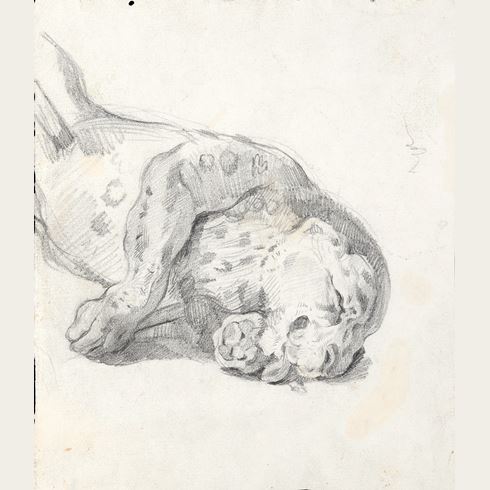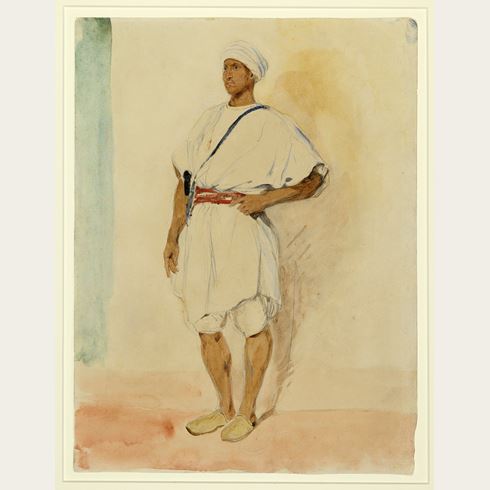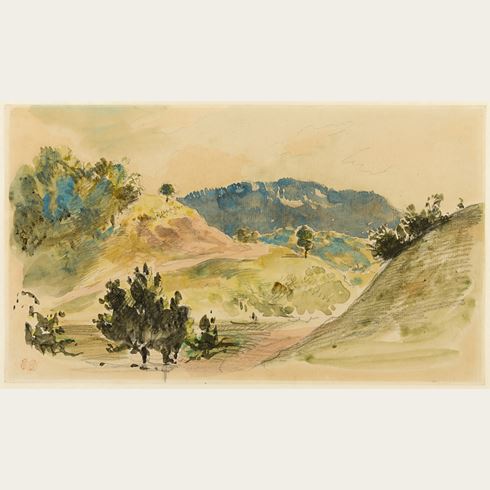Eugène DELACROIX
(Charenton-Saint Maurice 1798 - Paris 1863)
A Bugler on Horseback, Accompanied by a Hound
Sold
Pencil, grey and brown wash, with watercolour and gouache.
208 x 255 mm. (8 1/8 x 10 in.)
208 x 255 mm. (8 1/8 x 10 in.)
Although this fine drawing by Eugène Delacroix does not relate to any surviving painting, it is a splendid example of the artist’s spirited draughtsmanship. Unlike scenes of Oriental or medieval horsemen, contemporary military subjects are rare in Delacroix’s oeuvre; another example is a pencil study of a cavalryman on horseback, on the verso of a study of four horses in the Karen B. Cohen collection, New York. Delacroix’s interest in equine subjects dates from the beginning of the 1820’s, when he made numerous studies of horses; as the artist noted in his journal on the 15th of April 1823, ‘Il faut absolument se mettre à faire des chevaux, aller dans une écurie tous les matins’. Delacroix retained a lifelong interest in accurately capturing the appearance of horses at rest or in motion.
A related pencil study of a Siberian greyhound was in the Arosa and Suchet collections and was recorded in a drawing by Alfred Robaut in his catalogue of works by Delacroix. Two further drawings of greyhounds were also illustrated by Robaut; one a study of a single hound in profile formerly in the collection of Philippe Burty and the other a sheet of studies of greyhounds formerly in the collection of Georges Villot. A pencil study of what might be the same dog is in the Louvre.
The present sheet was once part of the extensive collection of drawings by Delacroix assembled by the French geologist Louis de Launay (1860-1938). De Launay was a lifelong friend of the Delacroix scholar and collector Etienne Moreau-Nélaton, and, like him, as a great admirer of the artist and inspired to collect his drawings. Louis de Launay assembled a large group of drawings by Delacroix, most of which were dispersed at auctions in Paris and London between 1979 and 1991. Five volumes of letters written by Moreau-Nélaton to Louis de Launay were recently acquired from the latter’s descendants by the Louvre. De Launay is said to have once noted that, ‘I always bitterly regretted not being Alfred de Vigny, Delacroix or Berlioz.’
A related pencil study of a Siberian greyhound was in the Arosa and Suchet collections and was recorded in a drawing by Alfred Robaut in his catalogue of works by Delacroix. Two further drawings of greyhounds were also illustrated by Robaut; one a study of a single hound in profile formerly in the collection of Philippe Burty and the other a sheet of studies of greyhounds formerly in the collection of Georges Villot. A pencil study of what might be the same dog is in the Louvre.
The present sheet was once part of the extensive collection of drawings by Delacroix assembled by the French geologist Louis de Launay (1860-1938). De Launay was a lifelong friend of the Delacroix scholar and collector Etienne Moreau-Nélaton, and, like him, as a great admirer of the artist and inspired to collect his drawings. Louis de Launay assembled a large group of drawings by Delacroix, most of which were dispersed at auctions in Paris and London between 1979 and 1991. Five volumes of letters written by Moreau-Nélaton to Louis de Launay were recently acquired from the latter’s descendants by the Louvre. De Launay is said to have once noted that, ‘I always bitterly regretted not being Alfred de Vigny, Delacroix or Berlioz.’
Eugène Delacroix has long been recognized as one of the finest draughtsmen of the 19th century in France. Adept in a variety of techniques – notably pen, pencil, watercolour, charcoal and pastel - he produced a large and diverse number of drawings of all types. As a modern scholar has noted, ‘For their number, variety and importance he attached to them, drawings are an essential, if not fundamental part of Delacroix’s oeuvre…they represent the most faithful testimonies of the man and the artist with his foibles but his greatness as well.’
However, Delacroix’s output as a draughtsman remained almost completely unknown and unseen by scholars, collectors and connoisseurs until the posthumous auction of the contents of his studio held in February 1864, six months after the artist’s death, which included some six thousand drawings in 430 lots. The sale included not only preparatory compositional sketches and figure studies for Delacroix’s paintings and public commissions, but a myriad variety of drawings by the artist, including studies of wild animals, landscapes, copies after the work of earlier masters, costume studies, scenes from literature, still life subjects and the occasional portrait, as well as finished pastels. In the words of the Delacroix scholar Lee Johnson, ‘It came as a surprise to many that an artist who had been so consistently criticized throughout his career for incompetence as a draughtsman and laxity in composition was revealed by the many hundreds of graphic works, the fifty-five sketchbooks, and scores of oil sketches at his sale to have been a draughtsman of extraordinary versatility and one who went to infinite pains to elaborate the compositions of his paintings through preliminary studies of many kinds, from the inchoate scribbles of an idea in germ, to more articulate designs, to detailed drawings of pose and gesture.’
The largest single collection of drawings by Delacroix, numbering almost three thousand individual sheets and twenty-three sketchbooks, is today in the Louvre.
Provenance
The artist’s studio, Paris, with the atelier stamp (Lugt 838a) at the lower right of the sheet
The Delacroix studio sale, Paris, Hôtel Drouot, 22-27 February 1864
Louis de Launay, Paris and Vilhémon, near Bessé-en-Braye
Thence by descent to a private collection, Paris, until 2008.
Literature
Edwart Vignot, ‘Actualité des ventes: 2008-2009, deux années pour mieux comparer…’, Bulletin de la Société des amis du Musée national Eugène Delacroix, No.8, 2010, p.68.








